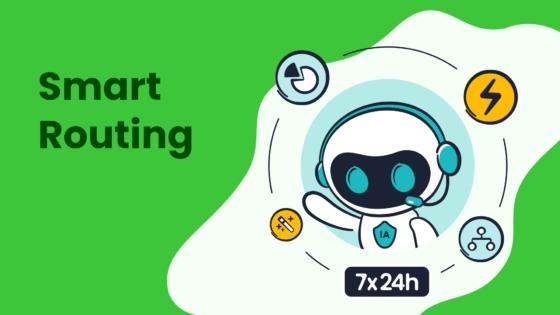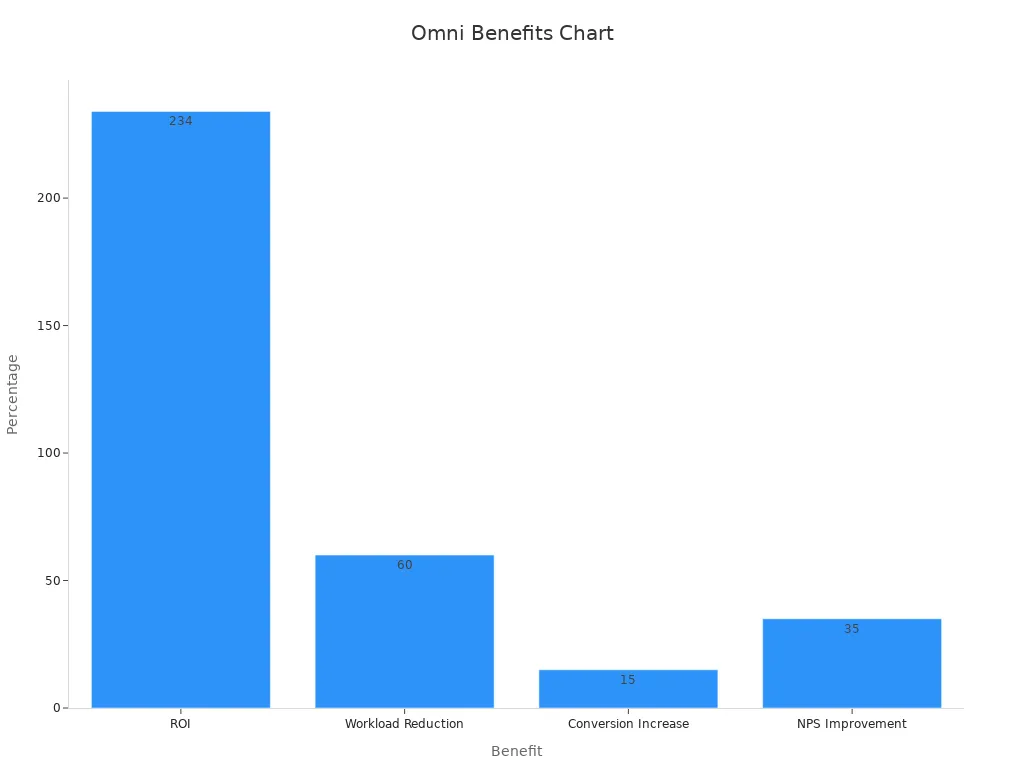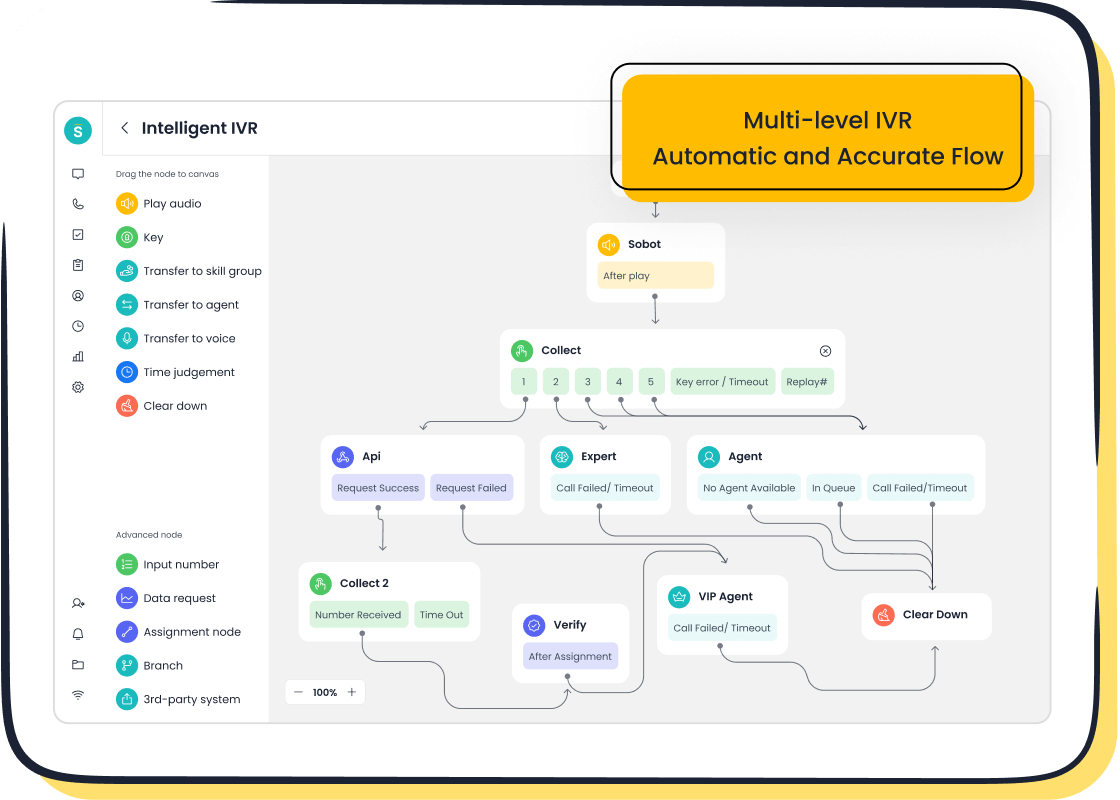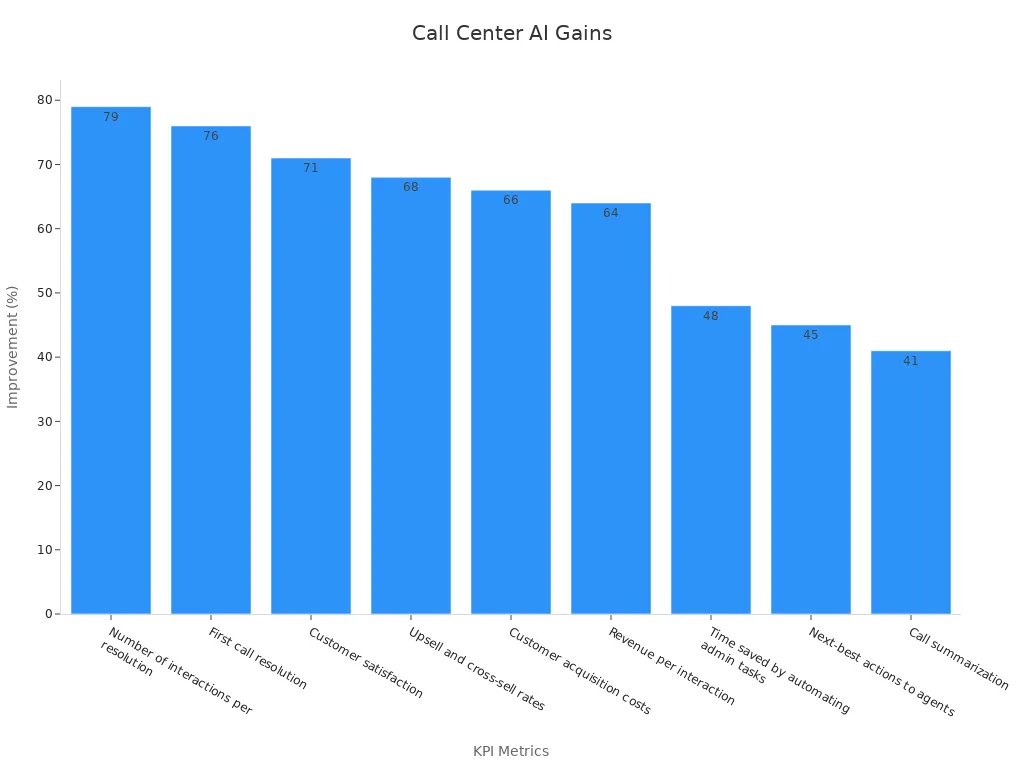How Contact Center Future Trends Are Redefining Service

Contact center future trends continue to reshape modern customer service with rapid advances in technology and AI. Today’s businesses see dramatic shifts from traditional call centers to agile, future-ready solutions like Sobot AI. Key changes include the rise of omnichannel strategies, automation, and data-driven insights.
- The global call center AI market is projected to reach $4.1 billion by 2027, reflecting strong adoption.
- Companies using omnichannel engagement report higher growth and customer satisfaction.
Sobot leads this evolution by offering unified, AI-powered platforms that improve efficiency and personalize every customer interaction.
Traditional vs. Future-Ready Contact Centers

Key Differences
Traditional contact centers rely on physical offices, on-premises hardware, and single-channel communication. Agents must work from a fixed location, and customers often wait longer for help. In contrast, future-ready centers use cloud-based call centers, which allow agents to work from anywhere. These centers support voice, chat, email, and social media in one platform. The table below highlights the main differences:
| Feature | Cloud Contact Center | On-Premises Contact Center |
|---|---|---|
| Setup | Quick, affordable, uses existing devices | Slow, complex, needs hardwiring |
| Scalability | Easy to add lines with a few clicks | Physical setup for each new line |
| Reliability | High uptime, regular software upgrades | Hardware failures, more downtime |
| Cost | Low upfront, pay-per-user | High upfront, ongoing maintenance |
| Remote Work Flexibility | Agents work from anywhere | Agents must be on-site |
| Customer Engagement | Omnichannel support | Separate handling per channel |
Service Models
Traditional centers use manual processes and focus on phone calls. Agents handle each customer one at a time, and repetitive tasks slow down service. Cloud-based call centers automate many tasks, such as routing calls and answering common questions. AI-powered chatbots and virtual assistants help customers 24/7. Over 75% of contact centers now use cloud systems, and by 2025, most agents will work in a remote call center or hybrid model. This shift improves speed and customer satisfaction.
Note: Cloud-based call centers can automate up to 70% of customer service work, letting agents focus on complex issues.
Technology Evolution
The evolution from traditional to future-ready centers centers on cloud and automation. Nearly 90% of firms now rely on cloud technology for their contact centers. Automation is expected to boost productivity by up to 40% by 2035. Cloud-based call centers support remote call center models, reduce costs, and offer real-time analytics. Sobot stands out as a leader in this space, providing unified, AI-powered solutions that help businesses scale quickly and deliver seamless service across all channels. With Sobot, companies gain a stable, secure, and flexible platform that adapts to changing needs.
Contact Center Future Trends
Contact center future trends drive a new era of modern customer service. Companies now focus on digital-first service, using cloud, ai, and automation to meet rising customer expectations. The market for contact center solutions shows rapid growth, fueled by demand for omnichannel integration and advanced technologies.
| Aspect | Details |
|---|---|
| Market Size 2022 | USD 28.09 billion |
| Market Size 2023 (expected) | USD 33.38 billion |
| Market Size 2030 (forecast) | USD 149.58 billion |
| CAGR (2023-2030) | 23.9% |
| Key Growth Drivers | Automation demand, omnichannel customer experience, cloud-based contact centers adoption |
| Fastest Growing Deployment | Hosted (cloud-based) segment |
| Dominant Enterprise Segment | Large enterprises (57% revenue share in 2022) |
| Fastest Growing Enterprise | Small & medium enterprises |
| Leading Region | North America (35% revenue share in 2022) |
| Fastest Growing Region | Asia Pacific |
| Dominant Industry Segment | IT & telecom (24% revenue share in 2022) |
| Fastest Growing Industry | Consumer goods & retail |
| Influential Technologies | AI integration, cloud adoption, managed services |
Digital Transformation
Digital transformation shapes the future of contact centers. Companies move from legacy systems to cloud platforms, enabling flexible and scalable operations. AI-driven automation and analytics now support real-time customer interactions and boost agent productivity. Many businesses adopt robotic process automation to handle routine tasks, reducing response times and improving customer experience. For example, Bank of America's AI assistant, Erica, has managed over 800 million inquiries, showing the scale of AI in action. Sobot’s cloud-based solutions help organizations embrace digital-first service, offering unified workspaces and seamless integration with existing systems.
- Shift to cloud-based platforms (CCaaS) accelerates adoption.
- AI and automation enhance operational efficiency.
- Customers expect multi-channel engagement and self-service.
- Analytics provide descriptive, predictive, and real-time insights.
- Automation tools reduce agent workload and improve response times.
Omnichannel Integration
Omnichannel integration stands at the core of contact center future trends. Businesses connect with customers across voice, chat, email, and social media, creating a seamless experience. Sobot’s omnichannel solution unifies all channels into one workspace, allowing agents to deliver consistent support. This approach leads to measurable benefits:
| Benefit | Statistic | Description |
|---|---|---|
| Return on Investment (ROI) | 234% | Significant financial gain from omnichannel integration |
| Agent Workload Reduction | 60% | Decrease in agent workload due to AI assistance |
| Conversion Rate Increase | 15% | Higher sales or engagement conversion rates |
| Net Promoter Score (NPS) Improvement | 35% | Enhanced customer satisfaction and loyalty |
| Resolution Time | Under 1 minute | Faster issue resolution combining AI and human agents |

J&T Express, for example, saw a 35% increase in sign-off rate and a 40% improvement in COD collection after adopting omnichannel integration. OPPO achieved a 93% customer satisfaction score through conversational support powered by Sobot. These results highlight the value of unified, AI-powered platforms in modern customer service.
Omnichannel integration not only improves customer experience but also drives higher ROI and agent efficiency.
Data-Driven Operations
Data-driven operations transform how contact centers deliver service. Companies monitor key metrics like customer satisfaction scores, first contact resolution, and average handling time to identify areas for improvement. Predictive analytics help forecast call volumes and customer needs, enabling better workforce management. Automation of routine tasks reduces agent workload and speeds up response times. Sobot’s unified workspace and analytics tools empower teams to make informed decisions and continuously improve service quality.
| Metric | Improvement Range |
|---|---|
| Average Handling Time | Decreased by 15-25% |
| First Contact Resolution | Improved by 20-30% |
| Customer Satisfaction Scores | Increased by 10-20% |
| Operational Costs | Decreased by 15-25% |
- Real-time data feedback supports ongoing adjustments.
- Data-driven training targets agent weaknesses.
- Personalized service comes from analyzing customer preferences.
- Proactive prediction of customer issues enhances experience.
Contact center future trends show that cloud, ai, automation, and omnichannel integration drive innovation and set new standards for customer experience.
AI Call Centers


AI call centers represent a major leap in customer service. Companies now use ai voice calling to automate routine tasks, answer questions, and route calls. Sobot’s AI-powered Voice/Call Center shows how advanced ai calling can change the way businesses interact with customers. These systems use scalable ai to handle large call volumes and provide support at any time of day. The future of ai voice calling promises even more improvements in speed and quality.
AI-Powered Automation
AI-powered automation drives the next generation of call center automation. Sobot’s platform uses ai voice calling to manage repetitive tasks, freeing agents to solve complex problems. This approach reduces human labor by up to 80%. Companies see cost savings between 15% and 35%. AI automation helps resolve tickets 52% faster and lets agents handle more customer inquiries per hour. With scalable ai, businesses can grow without adding more staff.
- AI virtual agents deflect about 25% of live calls, leading to faster resolutions.
- Customer satisfaction rises, with a 17% increase in Net Promoter Score (NPS) after AI deployment.
- ROI for AI can be achieved within months.
Chatbots and Voicebots
Chatbots and voicebots play a key role in ai call centers. Sobot’s ai voice calling features include multilingual support and instant responses. Voicebots improve customer satisfaction scores by up to 27%. They reduce average handling time by automating routine queries. These bots can handle up to 1,000 calls at once, making them ideal for busy periods.
- Collections rates improve by up to 21% with automated reminders.
- Voicebots use Natural Language Processing to understand accents and emotions.
- Real-time data from voicebot interactions helps managers make better decisions.
| Measurable Outcome | Description / Metric | Example / Case Study |
|---|---|---|
| Cost Savings | Up to 50% reduction in operational costs; $6M annual savings in healthcare example | Healthcare leader case study |
| First-Call Resolution (FCR) | Improvement up to 95% FCR rate | Telefónica: 6% increase in call resolution rates |
| Average Handling Time (AHT) | Reduced by 37% on average | Healthcare leader: 37% reduction in wait times |
| Customer Satisfaction (CSAT) | Increase by 15-20% | Telefónica and general voicebot data |
| Net Promoter Score (NPS) | +18 points increase | Swisscom case study |

Intelligent Routing
Intelligent routing stands at the heart of ai-driven call handling. Sobot’s ai voice calling system uses smart call routing to connect customers with the right agent. This reduces wait times and improves first-call resolution. Intelligent routing systems lower unanswered calls by distributing them evenly and redirecting when agents are busy.
- 83% of customers expect immediate engagement when contacting a company.
- 82% want to solve complex problems by talking to one person.
- 96% expect seamless omnichannel experiences.
| Statistic | Supporting Insight |
|---|---|
| 83% of customers expect immediate engagement | Quick routing reduces wait times and boosts satisfaction. |
| 82% expect to solve complex problems with one person | First-call resolution matters most. |
| 96% expect seamless omnichannel experiences | Omnichannel routing creates frictionless journeys. |
AI call centers powered by Sobot deliver faster, more accurate, and more personalized service. They use ai voice calling and scalable ai to meet rising customer expectations and set new standards for the future of ai voice calling.
Cloud-Based Call Centers
Cloud-based call centers have transformed customer service by offering unmatched scalability, flexibility, and integration. Companies now rely on cloud solutions to meet changing business needs and deliver superior customer experiences. Sobot stands out as a leader, providing a stable, secure, and globally accessible platform for businesses of all sizes.
Scalability
Cloud-based call centers allow organizations to scale operations instantly. Businesses can add or remove agents with just a few clicks, avoiding the delays and costs of traditional setups. During peak times, such as Black Friday, cloud-based call centers prevent long wait times and missed calls. Companies no longer need to invest in expensive hardware or physical space. The market for cloud-based call centers is projected to reach $77 billion by 2032, growing at a CAGR of 25.1% (source). Sobot’s cloud platform enables instant scaling, ensuring businesses stay agile and responsive.
- Cloud-based call centers support dynamic scaling for seasonal spikes.
- Quick setup requires only a subscription, not physical build-out.
- Companies can expand hours and integrate new channels easily.
Flexibility
Cloud-based call centers offer unmatched flexibility. Agents in a remote call center can work from any location with internet access. This supports business continuity and expands the talent pool. Cloud computing enables companies to adapt quickly to market changes, product launches, or sudden increases in demand. Sobot’s cloud-based call centers provide omni-channel support, AI-driven automation, and real-time analytics. These features help businesses personalize service and improve efficiency.
- Remote call center agents access systems from anywhere.
- Cloud-based call centers integrate multiple channels for seamless service.
- Real-time analytics and AI tools drive operational improvements.
Integration
Integration is a core advantage of cloud-based call centers. Cloud computing allows seamless connection with CRM systems and other business tools. Sobot’s platform integrates with Salesforce, Shopify, and more, creating a unified workspace for agents. This integration provides a holistic view of customer interactions, enabling faster and more accurate responses. Cloud-based call centers also support AI-powered chatbots and voicebots, enhancing agent productivity and customer satisfaction.
- Cloud-based call centers connect easily with existing business systems.
- Integration supports unified data and workflow automation.
- Businesses benefit from improved customer insights and streamlined operations.
Cloud-based call centers empower organizations to scale, adapt, and integrate with ease, setting a new standard for modern customer service.
Customer Experience
Personalization
Future-ready contact centers use advanced customer experience strategies to deliver highly personalized service. Sobot’s unified workspace brings together customer data from every channel, giving agents a complete view of each customer’s history and preferences. This approach allows agents to tailor responses and recommendations, making every interaction feel unique. Companies that use data and analytics can identify behavior patterns and pain points, leading to better service quality. Metrics such as Customer Satisfaction Score (CSAT), Net Promoter Score (NPS), and Customer Effort Score (CES) help measure the impact of personalization on customer engagement and loyalty. Post-call surveys and sentiment analysis tools also guide continuous improvement by capturing real-time feedback.
Personalization in contact centers leads to a 20% increase in customer satisfaction, according to recent studies.
Omnichannel Engagement
Omnichannel engagement stands at the core of modern customer experience strategies. Sobot’s platform integrates voice, chat, email, and social media, ensuring customers receive consistent support across all channels. This seamless approach allows customers to switch between channels without repeating information, creating a unified journey. The impact of omnichannel engagement is clear:
| Metric / Trend | Statistic | Impact on Customer Satisfaction |
|---|---|---|
| Customer retention rate | 89% vs 33% (non-omnichannel) | Higher loyalty and satisfaction |
| Spending increase by omnichannel customers | 30% more | Greater customer value |
| Expectation for personalized experiences | 71% | Drives satisfaction |
Customers who experience connected service shop 1.7 times more and spend 30% more, highlighting the value of integrated customer interactions (source).
Proactive Support
Proactive support transforms the customer experience by anticipating needs and resolving issues before they escalate. Sobot’s analytics tools enable agents to send timely notifications, such as shipping updates or payment reminders, which build trust and reduce customer effort. Predictive analytics help identify potential problems, allowing teams to act before customers reach out. Companies that adopt proactive support see a 9% increase in customer value and a 40% reduction in support case volume. Over 67% of customers respond positively to proactive notifications, showing improved satisfaction and loyalty.
- AI agents verify customers, detect sentiment, and prioritize urgent requests.
- Proactive outreach differentiates brands and fosters long-term engagement.
Benefits and Challenges
Business Value
Modern contact centers deliver strong business value through cost savings, scalability, and improved efficiency. Companies that invest in digital-first cloud strategies see measurable results:
- Nearly 90% of large organizations maintained or increased digital investments during the pandemic, highlighting the shift to cloud-based solutions.
- Cloud adoption enabled a global telecom company to accelerate product development by ten times.
- Automation and AI reduced procurement costs from 5% to 3.8% for an oil and gas company.
- Cognitive business command centers improved on-time order fulfillment from 71% to 93% for a chemical manufacturer.
Sobot’s cloud-based platform supports these outcomes with 99.99% uptime, global reach, and seamless integration. Businesses benefit from operational agility, lower costs, and the ability to scale quickly during peak periods.
Customer Value
Contact centers now focus on delivering a superior customer experience. Key performance indicators validate this shift:
- Customer Satisfaction Score (CSAT) measures how happy customers feel after each interaction.
- Net Promoter Score (NPS) tracks loyalty and the likelihood of recommending the brand.
- First Call Resolution (FCR) shows how often issues are solved on the first try.
- Customer Effort Score (CES) reveals how easy it is for customers to get help.
Studies show that 97% of consumers believe contact center interactions impact brand loyalty. Companies that excel in customer satisfaction see higher retention and revenue growth. Sobot’s unified workspace and AI-driven automation help agents personalize service, leading to better experiences and higher satisfaction.
Transition Hurdles
Transitioning to future-ready contact centers brings challenges:
- Data security remains a top concern as companies move to the cloud.
- Change management requires training and support for agents adapting to new tools.
- Maintaining a human touch is essential, even with increased automation.
Sobot addresses these hurdles with robust security, high system stability, and dedicated support for smooth transitions. Companies can confidently modernize their operations while protecting customer data and ensuring a seamless experience.
Case Study: Sobot and OPPO
Implementation
OPPO, a global leader in smart devices, faced rising customer inquiries during peak shopping periods. The company needed a solution to manage high volumes and deliver fast, consistent support. Sobot provided an all-in-one platform that unified live chat, ticketing, and customer messages. This centralized hub allowed OPPO to streamline workflows and reduce the time agents spent searching for information. Sobot’s AI-powered chatbots handled repetitive questions, while human agents focused on complex issues. The platform integrated with OPPO’s existing business systems, ensuring seamless data flow and a complete view of each customer. By adopting Sobot’s contact center future trends, OPPO improved internal organization and set the stage for scalable, efficient service.
Results
The deployment of Sobot’s solution produced measurable improvements for OPPO. The chatbot resolution rate reached 83%, showing that AI could independently resolve most customer queries. Positive feedback soared to 94%, reflecting higher satisfaction with faster, more accurate responses. OPPO also saw a 57% increase in repurchase rates, linking better service to stronger customer loyalty. Sobot’s AI agents managed over 50% of interactions, freeing human agents to address more complex needs. Outbound AI agents contributed to a sales increase of more than 30%. These results highlight how contact center future trends, such as automation and omnichannel integration, drive both operational efficiency and business growth.
Lessons Learned
OPPO’s experience with Sobot demonstrates the value of embracing contact center future trends. Centralizing communication channels drastically reduced response times and improved agent productivity. Automating routine tasks allowed human agents to focus on higher-value work, enhancing the overall customer experience. The case shows that integrating AI and omnichannel solutions not only improves service quality but also supports business scalability. Companies that adopt these trends can expect faster client responses, higher satisfaction, and increased sales. Sobot’s partnership with OPPO stands as a strong example of how modern contact center solutions deliver real-world results.
Preparing for the Future
Assessment
Businesses preparing for future-ready contact centers should start with a thorough assessment. Leaders need to review current technology, processes, and team skills. A technology audit helps identify gaps in digital tools and data management. Companies should align their goals with a clear vision for data and AI, securing support from all stakeholders. According to a 2023 study, 91.9% of organizations report measurable value from data and analytics investments. Sobot recommends evaluating integration readiness, knowledge management, and compliance with security standards. This foundation ensures that any new solution, such as Sobot’s unified platform, fits the company’s needs and supports long-term growth.
Adoption Steps
A successful transition requires a step-by-step approach.
- Prepare the organization by building a strong framework for data literacy and AI readiness.
- Start with proven tools like advanced analytics and robotic process automation to boost efficiency.
- Deploy AI-powered agent assist features to help agents in real time.
- Gradually add advanced AI, such as auto-summarization and automated quality checks.
- Pilot new technologies, collect feedback, and refine before full rollout.
- Track progress with clear metrics and dashboards linked to business outcomes.
Tip: Sobot’s cloud-based solutions allow businesses to pilot features like AI chatbots and omnichannel support, making it easier to test and scale innovation.
Continuous Improvement
Continuous improvement keeps contact centers competitive.
- Automate repetitive tasks to free agents for complex issues.
- Set SMART goals and benchmark performance against industry standards.
- Gather feedback from both customers and agents through surveys and regular meetings.
- Invest in ongoing training and encourage participation in industry certifications.
- Foster a positive culture that values agent input and collaboration.
Sobot’s analytics tools help teams monitor real-time metrics, identify trends, and adjust customer experience strategies. Companies that focus on improvement see lower agent turnover and higher customer satisfaction. By experimenting with new support channels and refining workflows, businesses can stay ahead in a fast-changing market.
Contact center future trends continue to transform service by integrating ai, cloud, and omnichannel solutions. Companies using cloud-based call centers and ai voice calling see faster response times, higher first-call resolution, and lower costs. Sobot’s platform unifies customer data, automates routine tasks, and delivers 24/7 support. Businesses adopting ai and cloud-based call centers gain a competitive edge, improve customer satisfaction, and adapt quickly to change. Proactive adoption of ai, cloud, and omnichannel strategies helps organizations retain more customers and drive growth. Now is the time to explore future-ready solutions like Sobot to stay ahead.
FAQ
What are the main benefits of adopting contact center future trends?
Businesses gain faster response times, higher customer satisfaction, and lower costs. For example, Sobot’s cloud-based platform delivers 99.99% uptime and supports global operations. Companies using contact center future trends report up to 35% higher Net Promoter Scores (source).
How does Sobot support omnichannel engagement in contact center future trends?
Sobot unifies voice, chat, email, and social media in one workspace. Agents see all customer interactions in real time. This approach improves efficiency and ensures customers receive consistent support. Omnichannel engagement remains a core part of contact center future trends.
Why is AI important in contact center future trends?
AI automates routine tasks, provides 24/7 support, and improves first-contact resolution. Sobot’s AI-powered chatbots handle up to 83% of inquiries for clients like OPPO. AI in contact center future trends helps businesses scale and deliver personalized service.
What challenges do companies face when adopting contact center future trends?
Companies often face data security concerns, agent training needs, and the challenge of maintaining a human touch. Sobot addresses these issues with robust security, user-friendly tools, and dedicated support, making the transition to contact center future trends smoother.
How can businesses start implementing contact center future trends?
Leaders should assess current systems, pilot new technologies, and train teams. Sobot recommends starting with a technology audit and testing AI chatbots or omnichannel solutions. Adopting contact center future trends step by step helps ensure long-term success.
See Also
Best Cloud-Based Contact Center Services Evaluated For 2024
Leading Contact Center Technologies Assessed For The Year 2024
Revealing The Best Cloud Contact Centers Of 2025
